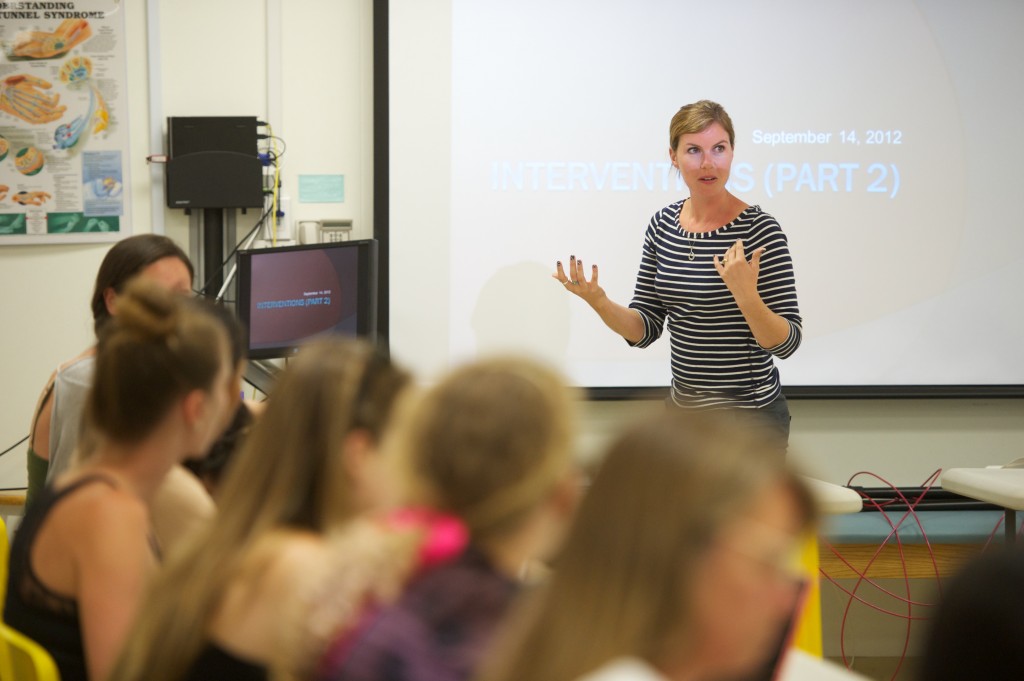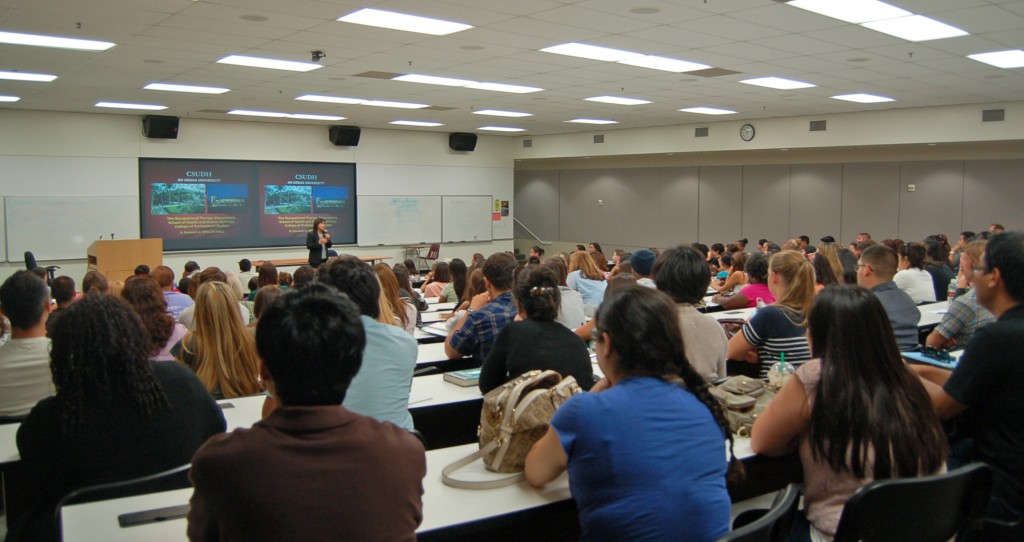Now in his third semester in the Master of Science in Occupational Therapy (MSOT) program at California State University, Dominguez Hills, Edward Kim is focused on pediatrics. He along with one of 69 students from the program’s eighth cohort are in the field once a week at the Speech and Language Development Center in Buena Park, working with low-functioning children with autism, including some who don’t use speech to communicate.
“We’re coming up with activities that will improve [communications skills] in the classroom setting. We work on handwriting, how to make handwriting fun,” said Kim, 27, who is interested in working as a hand therapist or in the area of geriatrics because he saw how his grandfather suffered from Alzheimer’s disease. “We work on fine motor skills, working on crafts, helping to glue things together.”

Last semester, Kim and his MSOT colleagues were focused on adolescents, learning how to treat high-functioning teens with learning disabilities. After moving through the curriculum together and by the time they graduate in 2014, this group will have covered the entire lifespan, from neonatal to children, teens, adults, and geriatrics, as well as mental issues, and be prepared to work as certified occupational therapists.
Treasurer of the Student Occupational Therapy Association Rachel Lo said there is a “built-in support system” throughout the seven-semester program.
“Within our cohort, we all take the same classes at the same time, so we are able to help each other with assignments or studying. We even have a Facebook page for just our cohort so we can post questions and answers for anything we need help with,” Lo said of cohort eight. “[Students from the previous cohort help] us understand what to expect, what to stress about or not stress about, and give us good advice on how to get through the program.”
After the initial semester of introduction topics, the curriculum is designed to devote entire semesters focused on age-related populations, and progressively increases in critical reasoning and thinking across the succeeding four semesters.
“Within [each] semester we have a course on theory, assessment, intervention, – conditions, case seminar, and research. [It is] quite comprehensive,” said Terry Peralta-Catipon, associate professor and chair of the Department of Occupational Therapy and director of the MSOT program.
In addition to the courses, the students are required to complete off-campus fieldwork at practice sites for each segment of the program.

“Our curriculum design, and our philosophy as a program, really is to find a nice balance and ways to bridge theory and practice. So while they’re learning it in the classroom, once a week [the students] go to a clinic and see it happen,” Peralta-Catipon said.
The students find the program’s structure not only educationally beneficial, but more enjoyable.
“It’s cool because we get to see the actual kids use what we’re learning in class. … It’s easier to learn from that than to look at [PowerPoint] slides,” said Kim who received his B.A. in communications studies from University of California, Los Angeles.
Nicole Lokietz, who graduated from UC Santa Barbara with a bachelor’s in global studies, is doing her third-semester fieldwork at a sensory integration clinic, similar to a gym, where she uses apparatus such as trampolines and swings to work with patients with autism, cerebral palsy, ADHD and other afflictions. Although, there is some crossover between what she does at the clinic and physical therapy, they have different approaches and functions.
“While physical therapy centers on the components of movement: ambulation, balance,, strength and endurance, OT focuses on independence and function, engagement in daily activities and tasks that gives life meaning. OT aims to help individuals maximize their ability to ‘live life to its fullest’,” Peralta-Catipon explained.
As the baby-boomer generation ages, students who chose geriatrics as their area of specialization will be able to serve the increasing need for occupational therapists. According to the U.S. Bureau of Labor Statistics, there is currently a shortage of occupational therapists in the United States and OT personnel are expected to increase 33 percent from 2010 to 2020.
Peralta-Catipon said new OT graduates can expect to work in clinical and home health settings, schools and community programs, earning an average annual salary of $70,000 to $95,000, depending on the practice area.
To help fray costs while in school, Los Angeles Unified School District recently offered CSU Dominguez Hills with five $5,000 scholarships to be awarded to the university’s OT students who commit to work in the school district clinics or classrooms upon graduation. Last year, the association Hand Therapy of Greater Lost Angeles (HTGLA) granted the Program $20,000 for students interested in becoming hand therapists.
Through alumni and employer surveys, Peralta-Catipon conservatively estimates that 95 percent of students are hired as OT practitioners within six months to a year of graduation from the university’s rigorous 96-unit master’s program, with many going into the facilities where they served their internships.

“I always get a lot of feedback from clinicians and those who serve as our field work educators–the clinical supervisors of our students–that our students are good, that our students hit the ground running,” Peralta-Catipon said.
For the first time since its initial accreditation in 2005–when the program transitioned from a Bachelor of Science program to an entry-level MSOT program–it is in the process of being reaccredited through the American Occupational Therapy Association‘s Accreditation Council for Occupational Therapy Education, which is the accrediting agency for occupational therapy education by both the United States Department of Education and the Council for Higher Education Accreditation. Results should be announced in spring 2013.
Unlike many other programs, OT requires accreditation to remain operational. Peralta-Catipon explained that students from unaccredited OT programs aren’t eligible to take the required board exam for licensure by the National Board for Certification in Occupational Therapy, which is required to practice OT anywhere in the nation. Ninety-eight percent of the 155 CSU Dominguez Hills students who graduated from 2009 to 2011 have passed the exam.
Compared to other institutions, the university’s program admission requirements are demanding, requiring a 4.0 on the writing segment of the GRE, and students must maintain a cumulative GPA of 3.0 or higher through graduation.
As part of admissions requirements, applicants must attend an information session. In July, Peralta-Catipon outlined the program to a standing-room-only crowd of potential applicants in the 250-seat Claudia Hampton Hall. In spring 2013, the program will admit 69 students into its ninth cohort, bringing its active enrollment to 210.
One of only seven OT schools in California, CSU Dominguez Hills has the second largest entry-level master’s program after University of Southern California, and along with San Jose State University, is one of only two state-funded programs. According to Peralta-Catipon, the program at CSU Dominguez Hills ranks well across the nation, attracting applicants from throughout California as well as out of state.
“When I would tell people that I was considering the OT program at CSUDH they would always respond positively. … By the time I attended the orientation I was 100 percent sure this was the school I wanted to be at,” said Anna Homrighausen, president of the Pi Theta Epsilon Honor Society. “And on top of everything, you really can’t beat the cost. Student loans are a lot to take on, but here, I feel comfortable with the tuition.”
For more information on the MSOT program, click here.
For more information about the Student Occupational Therapy Association, email sotacsudh@gmail.com.